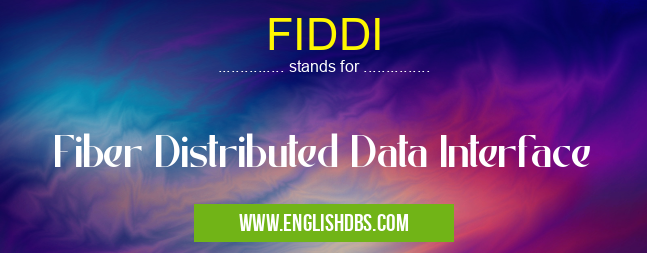What does FIDDI mean in NETWORKING
FIDDI stands for Fiber Distributed Data Interface. It is a high-speed data transmission technology that uses optical fibers. FIDDI operates at a data rate of 100 Mbps and can support up to 500 nodes. It is used in campus and metropolitan area networks.

FIDDI meaning in Networking in Computing
FIDDI mostly used in an acronym Networking in Category Computing that means Fiber Distributed Data Interface
Shorthand: FIDDI,
Full Form: Fiber Distributed Data Interface
For more information of "Fiber Distributed Data Interface", see the section below.
» Computing » Networking
FIDDI Components
- Fiber Distributed Data Interface (FDDI) is a network technology that uses optical fiber to transmit data.
- It is a token-passing network, which means that each node on the network has a chance to transmit data.
- FDDI uses a dual-ring topology, which means that there are two paths for data to travel between nodes.
- This makes FDDI very reliable, as data can still be transmitted even if one of the rings fails.
FIDDI Advantages
- High speed: FDDI operates at a data rate of 100 Mbps, which is much faster than other network technologies such as Ethernet.
- Low latency: FDDI has a very low latency, which means that there is very little delay in transmitting data.
- High reliability: FDDI is a very reliable network technology, as data can still be transmitted even if one of the rings fails.
- Scalability: FDDI can support up to 500 nodes, which makes it a scalable network technology.
FIDDI Disadvantages
- High cost: FDDI is a more expensive network technology than other technologies such as Ethernet.
- Complexity: FDDI is a more complex network technology than other technologies such as Ethernet.
- Limited distance: FDDI has a limited transmission distance of about 2 kilometers, which makes it less suitable for long-distance networks.
Essential Questions and Answers on Fiber Distributed Data Interface in "COMPUTING»NETWORKING"
How does FIDDI work?
FIDDI uses a ring topology, where each node is connected to its two neighboring nodes, forming a closed loop. Data is transmitted around the ring in a token-passing fashion. Nodes can only transmit data when they possess the token. This ensures that only one node transmits at a time, preventing collisions and ensuring data integrity.
What are the advantages of FIDDI?
FIDDI offers several advantages, including:
- High bandwidth: FIDDI supports data transmission rates of up to 100 Mbps, enabling high-speed data transfer.
- Long distance: FIDDI can transmit data over distances of up to 100 kilometers without requiring repeaters.
- Reliability: The ring topology provides redundancy, ensuring that if one node fails, data can still flow around the ring.
- Scalability: FIDDI networks can be easily expanded by adding or removing nodes as needed.
What are the limitations of FIDDI?
FIDDI has some limitations, such as:
- Cost: FIDDI networks can be expensive to implement and maintain due to the use of fiber-optic cables and specialized equipment.
- Complexity: FIDDI networks can be complex to configure and manage, requiring specialized expertise.
- Latency: FIDDI networks may experience higher latency compared to other network technologies, as data must travel around the entire ring before reaching its destination.
Is FIDDI still used today?
While not as common as in the past, FIDDI is still used in certain applications where high bandwidth, reliability, and long distance transmission are required. However, it has been largely replaced by newer technologies such as Ethernet and SONET.
Final Words: FIDDI is a high-speed, low-latency, reliable, and scalable network technology. It is used in campus and metropolitan area networks. While FIDDI is a more expensive and complex technology than other technologies such as Ethernet, it offers higher performance and reliability.
